Self-service passenger check-in at the driver's.
- Articles and technical information
- Articles
The article describes one of the options for self-service passenger check-in when boarding through the front doors using both bank and non-bank contactless cards. The advantage of the system is that in cases where passengers do not have a card or purchasing tickets is more complicated, check-in can be done in cash with the driver.
The principle of self-service passenger check-in through the front doors.
The fundamental principle of "self-service passenger check-in through the front doors with driver control" is that passengers board through the front doors and use the EVK 5.0 BP validator located near the driver to:
1. Select the fare and purchase a ticket using a bank or non-bank contactless card, or
2. Tap one of the cards to check in using a subscription (in the case of a bank card, it serves as the passenger's identifier).
3. Only if passengers cannot use options a or b, they can purchase a ticket in cash from the driver (usually at a slightly higher price). This also applies to group tickets (e.g., for schools).
The driver, therefore, does not need to interact with passengers, and at the same time, they can see on their LCD terminal how passengers are checking in, such as which type of ticket they are purchasing or which subscription they are using. This allows them to easily detect situations where a card may have been misused by an unauthorized user or where the card has already been used to pay for a ride during the journey. The system is also prepared for situations where a user's photo can be uploaded to it and displayed to the driver in a format approved by the Office for Personal Data Protection.
This check-in concept speeds up the passenger boarding process, simplifies the driver's tasks, and reduces the likelihood of misuse of contactless cards. The display on the driver's EPT 4.08B LCD terminal (as shown in figure 1 on the left after subscription check-in) and the EVK 5.0 BP validator's screen (on the right, the basic screen) are quite similar.
This check-in principle is especially suitable for cities with "small" urban public transportation systems that have a straightforward fare structure with only a few options, as demonstrated in figure 2, where the validator's basic screen offers only 9 purchasing options. In operation, passengers:
1. Approach the validator, select their ticket type, and simply tap their card. The EVK 5.0 validator recognizes the contactless card (bank or non-bank) and processes the payment, deducting it from either an electronic wallet or a bank card.
2. If a valid subscription is loaded on the card, passengers can check in by simply tapping the card. The validator verifies the card, and the passenger can proceed with boarding. In this case, the driver sees the basic card information. This is evident from the following image, where the passenger checked in using a subscription, was an adult, and had a defined subscription validity (coupon). Additionally, the content of the electronic wallet is displayed on the validator for the passenger.
The driver can intervene in the check-in process at any time, and passengers can purchase tickets in cash from the driver. Tickets purchased from the driver are more expensive, so the driver's terminal displays higher prices than those shown on the terminal. For example, the full fare costs 20 Kč in cash, while it costs only 18 Kč when purchased from the electronic wallet. Additionally, the driver sells more complex tickets, such as those for school classes or diverse groups of passengers (multi-ride tickets).
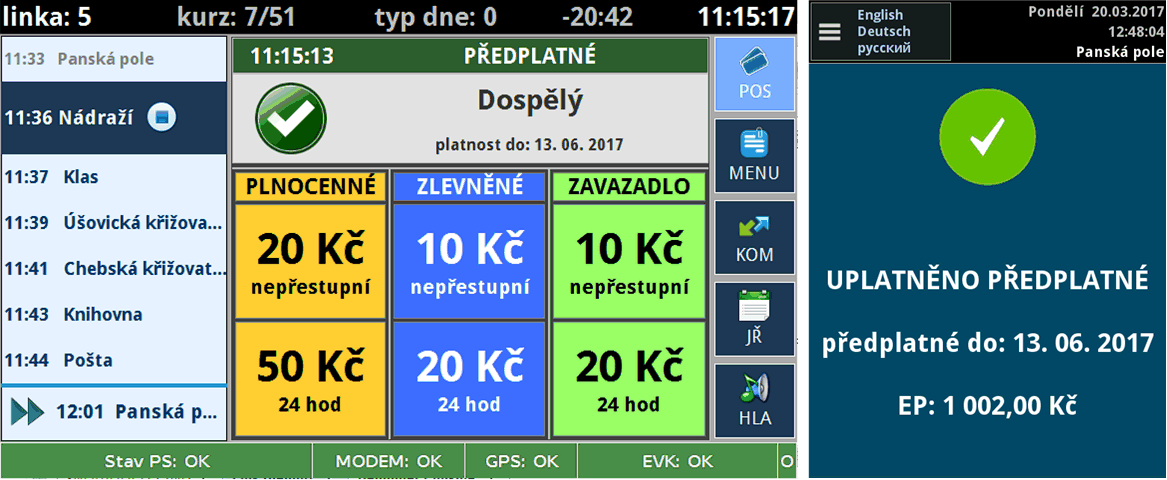
Fig. No. 3: Screenshots of the driver's terminal (left) and the validator (right) during subscription check-in.
The core functions of the check-in system align with the typical tasks performed by a driver in similar systems. When the system is powered on, it initializes and checks the status of connected devices (peripherals, indicated on the lower row). After the driver logs in using a contactless card or a PIN (for driver identification) and selects their service (shift), they can access their check-ins and choose their service (or shift).
In this scenario, the driver is guided throughout their entire shift by the onboard computer, including the option to use an alarm clock during breaks at the terminals. The process of managing check-ins can be paused at any time, and the system can be locked, for example, during a lunch break.
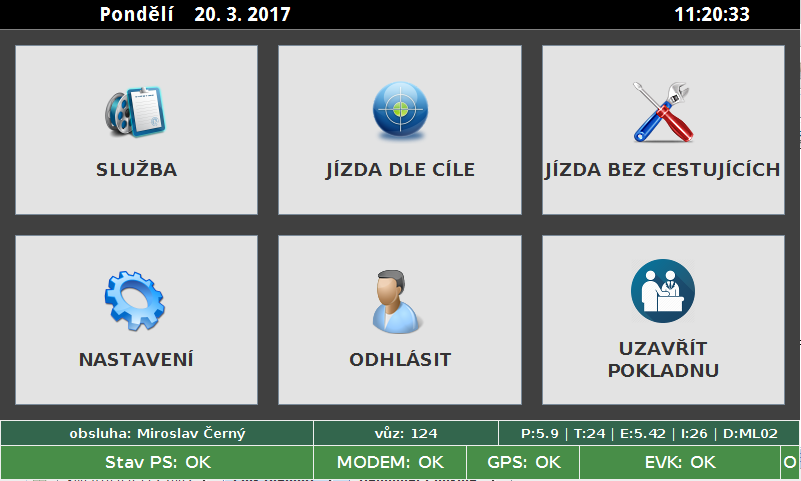 Fig. No. 4: The driver's main menu after logging in and before opening the check-ins (the "OPEN CASH REGISTER" button).
Fig. No. 4: The driver's main menu after logging in and before opening the check-ins (the "OPEN CASH REGISTER" button).
During the ride, the driver primarily just monitors self-service check-ins (excluding cash payments) - see figure number 5. As an example, a successful payment from a non-bank card's electronic wallet is shown in the following image, where the driver can see the passenger's payment
 Fig. No. 5: Example of a non-bank card payment on the driver's terminal (left) and on the validator (right).
Fig. No. 5: Example of a non-bank card payment on the driver's terminal (left) and on the validator (right).
The driver can also view the payment history on the screen and, if necessary, can initiate the cancellation of a sold ticket. The time frame within which ticket cancellations can be set is a system configuration parameter to prevent drivers from attempting to enrich themselves.
In the event that a passenger uses an invalid card, the driver is informed about it (see the following image). Simultaneously, the validator's beep changes from a confirmation sound to a warning sound, thereby audibly alerting the surroundings.

Fig. No. 6: Example of using a blocked non-bank card on the driver's terminal (left) and on the validator (right).
In the case of payment with a bank card, the passenger selects the fare themselves. After their selection, online payment authorization is performed with the bank - see Figure No. 7 (we apologize for the transaction mismatch). Currently, we are also preparing for offline payment with bank cards.
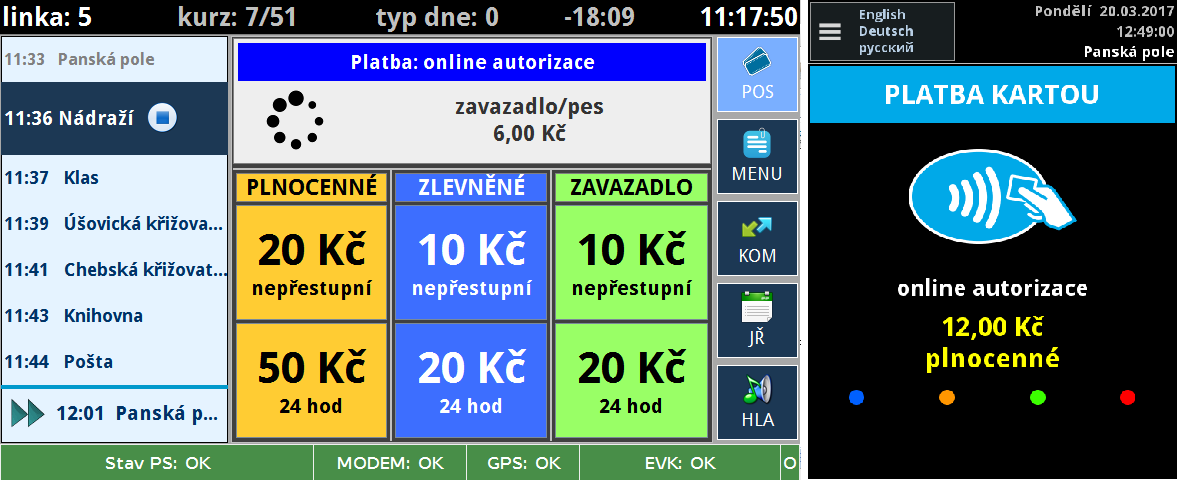
Fig. No. 7: Example of payment with a bank card for a full-fare ticket and display on the driver's screen (left) and the validator (right) - please excuse the transaction mismatch.
In the case of passenger check-in with cash payment, the driver enters the fare, and the driver's terminal displays the following screen after entering the ticket information. Subsequently, the validator EVK prints the ticket, and the transaction status is displayed on the validator.
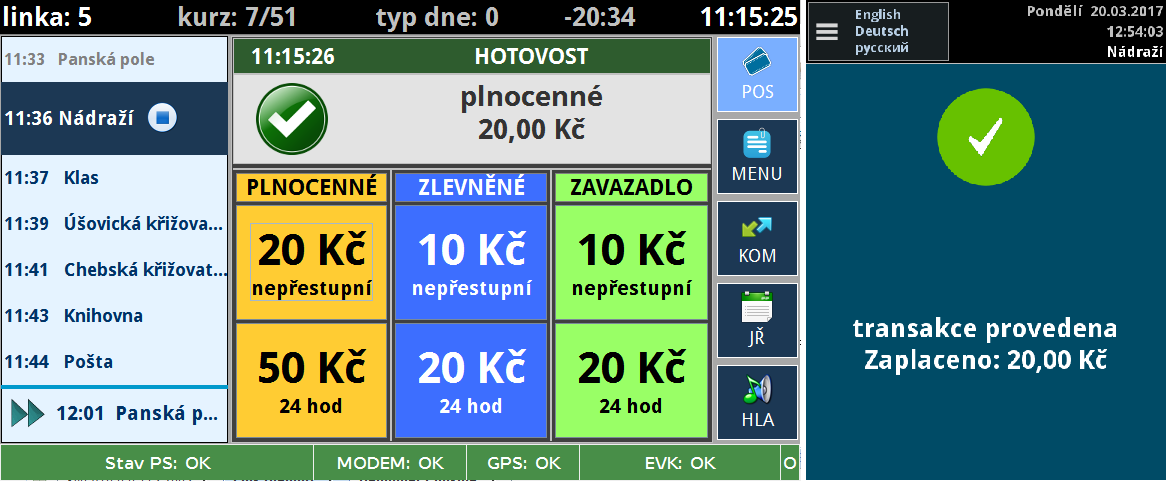
Fig. No. 8: Example of cash payment for a full-fare ticket on the driver's terminal (left) and on the validator (right).
Less commonly used check-in functions are accessed through a special menu, which is accessed through a "sub-menu" in the check-in system. Within this menu, several functions are available, including:
- Ticket cancellation
- Issuance of group tickets
- Printing a test ticket
- Check-in history
- Card verification
- Validator status check
Additionally, there are other supplementary functions such as document display for the driver, viewing timetables stored in the onboard computer, and more.
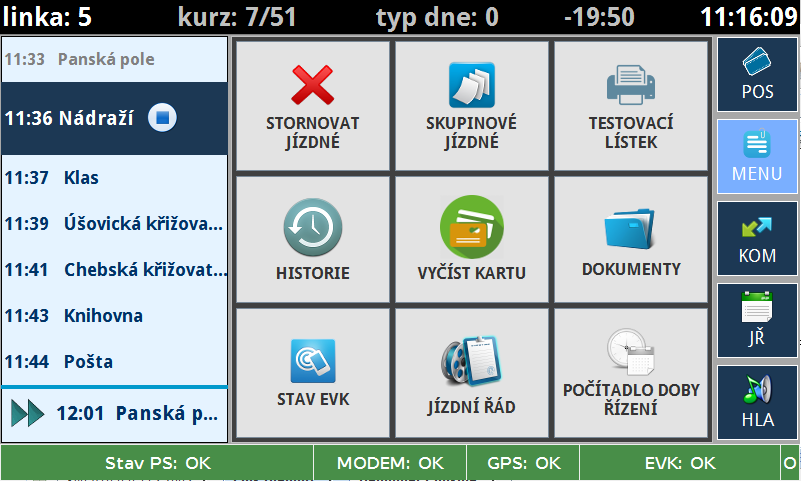
Fig. No. 9: Selection of supplementary check-in functions on the driver's terminal.
One of the options is to purchase a group ticket from the driver, which can be paid for either in cash or with a bank card. After the driver selects the first ticket (e.g., a 60-minute validity type), they are allowed to add additional tickets only for this type of fare. Other rows become inactive for this purpose.
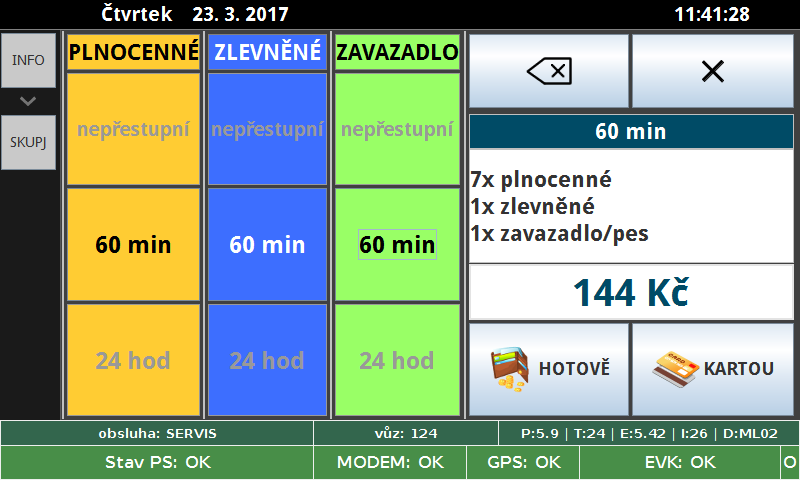
Fig. No. 10: Example of a group ticket on the driver's terminal.
If a passenger needs to access card information (such as coupon status, balance on the electronic wallet, validity, etc.), they must request the driver's permission to read the card (see the sample data display on the EVK below). The driver has the option to cancel the ongoing card information display in case the passenger leaves or if it hinders the smooth check-in of other passengers.
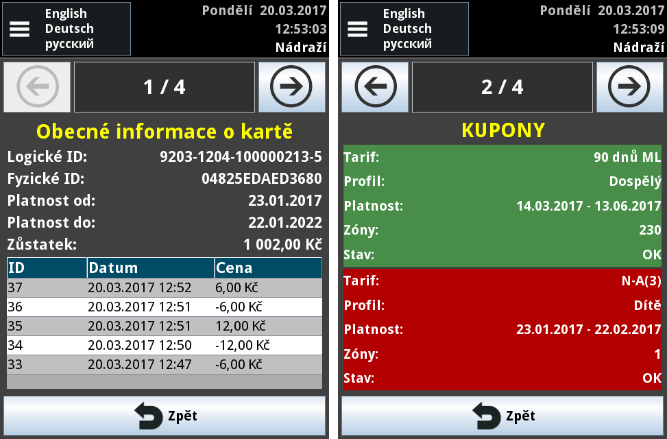
Fig. No. 11: Example of reading the first two screens on a non-bank card.
Elements of the system and their relationships.
The advantage of this solution is that it combines both the check-in and information system (referred to as OIS). This means that the onboard computer EPIS controls all the relevant peripherals (e.g., information systems), simultaneously performs check-in through the EVK 5.0 validator, and manages the vehicle's communication with the dispatch center and back office for transaction management.
For the OIS system to function, the following operating conditions must be met:
1. The vehicle must be equipped with the relevant technology, including the onboard computer EPIS 4.0x, a touch LCD driver EPT 4.08B, and the EVK 5.0BP validator with a combined contactless card reader (including offline check-in).
2. For communication between the vehicle and the dispatch center (surroundings), a mobile network operator's network will be used in APN (access point network) mode or fixed IP address mode. Communication mode will utilize UMTS or LTE technology, which uses the GSM network with the EPG 4.0x modem.
3. Dispatch server - a lightweight (simplified) version of the SPRINTER 2016 software intended for tracking the vehicle's location and data uploading/downloading to/from the vehicles (RADON service).
4. Back Office, including data preparation for onboard computers. The software will be capable of sending check-in data for non-bank cards to clearing and processing all transactions.
5. Data preparation for onboard computers is performed in the EPCOMP II software based on information from timetables.
Fig. No. 12: An example of the possible organization of data flow and communication within the system.
Data Updates in the Vehicle:
Data updates are performed only when the onboard computer is powered on and rely on GSM communication. The vehicle can be woken up in the depot upon request using low-power communication, which checks for new versions and doesn't affect the vehicle's consumption. Subsequent communication then occurs through GSM/GPRS/UMTS/LTE networks. The system is prepared for remote timetable updates, automatic tachograph reading, passenger LCD updates, and other components (e.g., camera systems).
Database Organization for Vehicle Transactions:
To enhance system reliability in terms of transaction backups, the system employs triple redundancy. The primary transaction database is within the validator, which also includes a "black box" – an independent memory storing all performed transactions, tightly integrated with the validator. Another backup is provided by the memory in the onboard computer, and transactions are synchronized with the back office. This configuration achieves a high level of data backup for check-in transactions.
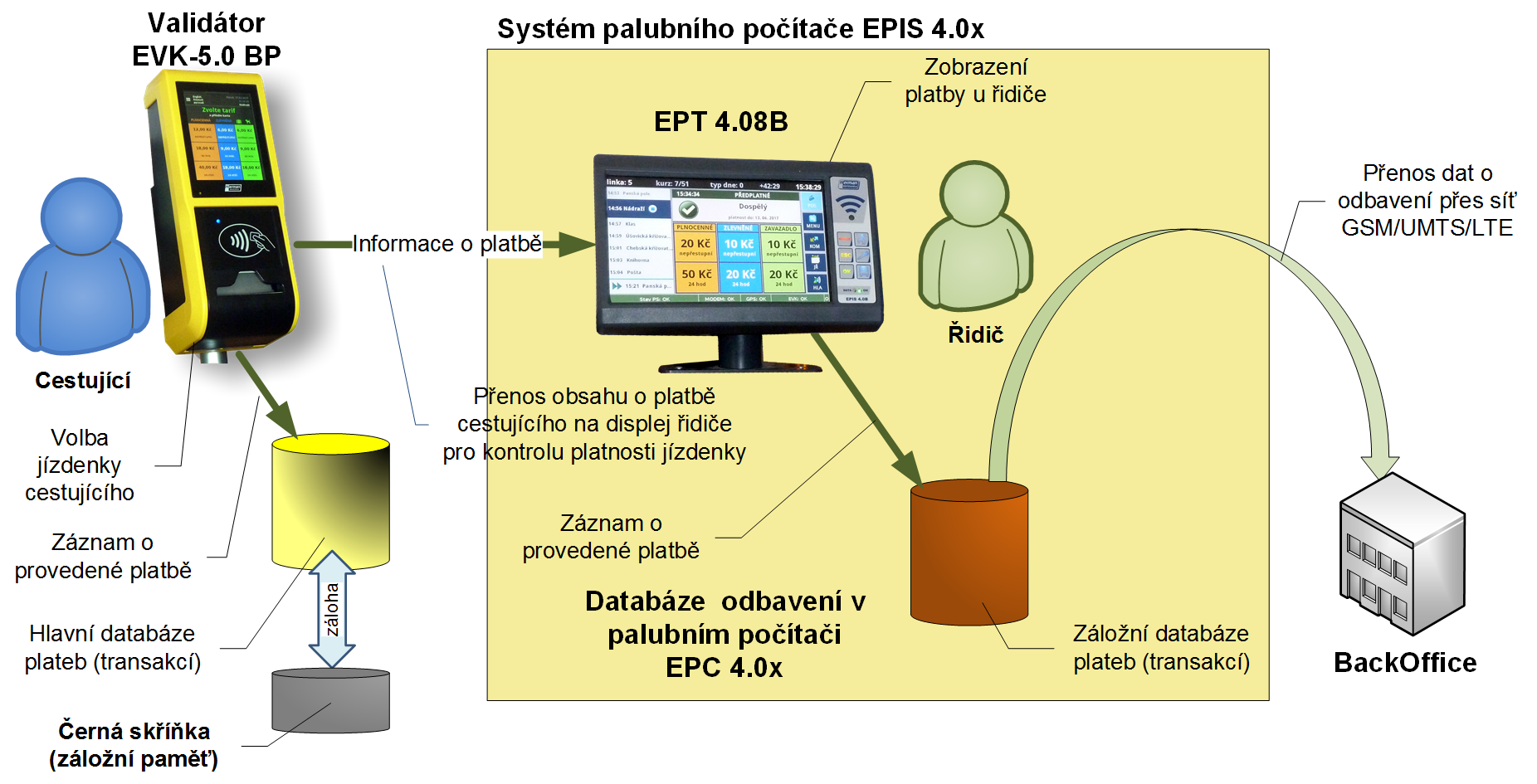
Fig. No. 13: The organization of transaction databases within the system to enhance security.
Composition of the Check-in and Information System of the Vehicle
The organization of the vehicle addresses two fundamental functions – check-in and information dissemination, and the associated communication connections.
Passenger check-in is based on two key devices that are interconnected – the onboard computer EPIS and the validator EVK. The information and communication system is already in standard form, with communication to the dispatch center facilitated through GSM modems (EPG 4.0x) with at least a 3G (UMTS) modem. The vehicle's equipment is built on other standard components, such as destination boards, LCD displays for passengers, command receivers, tachographs, and more – as shown in the following illustration.
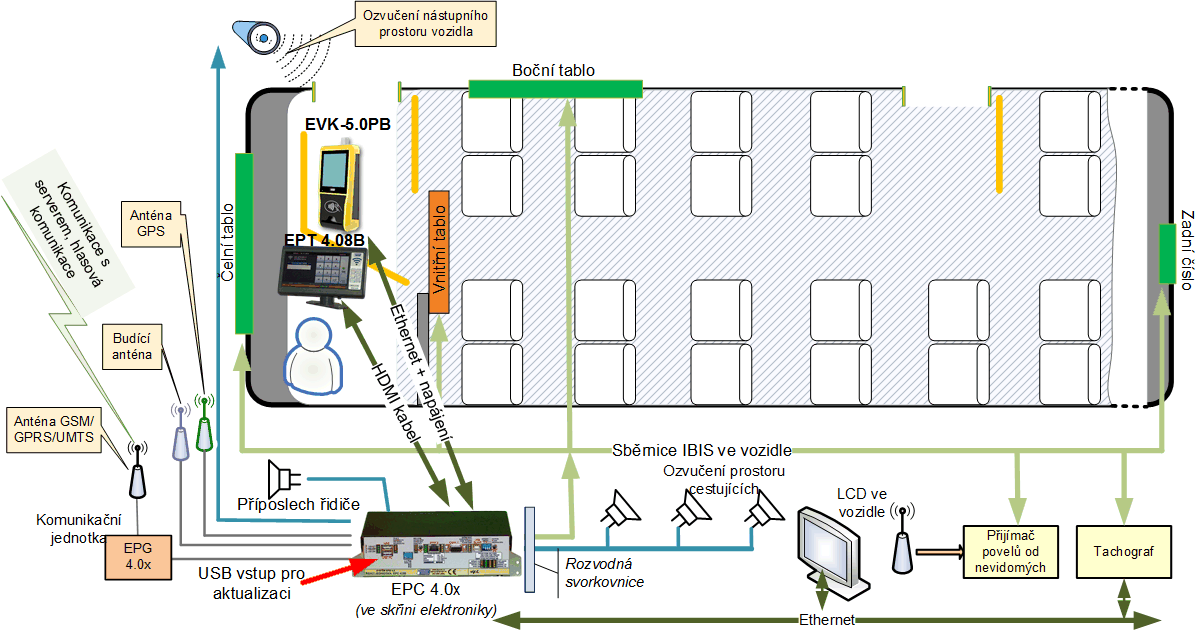 Fig. No. 14: Example of the vehicle configuration with a highlighting of the OIS components' placement within the vehicle.
Fig. No. 14: Example of the vehicle configuration with a highlighting of the OIS components' placement within the vehicle.
The provided solution includes the following key units:
- Control unit of the onboard EPIS system – EPC 4.0x – which serves as the control unit for the onboard EPIS 4.x system, with control functions for passenger check-in, management of information systems, and communication capabilities. The system's performance allows for the integration of new functions or the addition and control of additional peripherals.
- Touchscreen driver's LCD terminal EPT 4.08B with the ability to authenticate non-bank payment cards (may include a card reader) and connection via a single HDMI cable. The precise method of driver authentication will be defined according to the needs of the transport company, or it may be used as a backup for passenger check-in.
- GSM/GPRS/UMTS modem of the EPG 4.0x type, which will be connected to the control unit of the onboard EPIS system EPC via a USB interface. The modem provides communication speeds of up to 30 Mbit/s in LTE configuration.
- Check-in unit EVK 5.0 BP – this unit contains a fast thermal printer with extended durability and a combined contactless card reader (banking and non-banking, including an offline mode). The unit also features a large color customer display with capacitive touchscreen control for individual check-in.
The check-in and onboard computer system also allow for many other expansion possibilities that are not part of this description, such as remote tachograph reading, vehicle temperature measurement, remote heating activation, engine runtime measurement, and more. These options can reduce operational costs in the future and provide a higher utility value to the system, as well as opportunities for further development.
